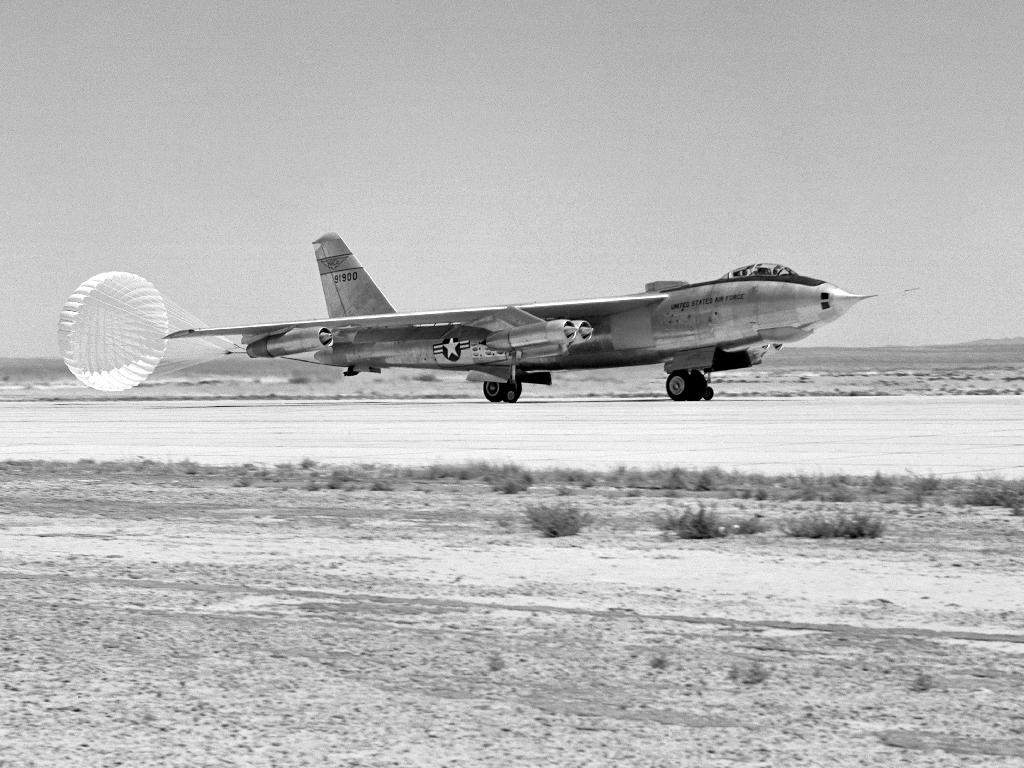B-47A Stratojet
 August 12, 1953 NASA Photo
August 12, 1953 NASA Photo
Boeing B-47A (NACA 150) shown on the ramp near NACA High-Speed Flight Research Station at South Base of Edwards Air Force Base, California
The B-47A (49-1900) bomber was the first to be built at the Boeing Aircraft Company in Witchita, Kansas. NACA* (National Advisory Committee for Aeronautics) High-Speed Flight Research Station obtained that B-47A Stratojet (NACA 150) to study the characteristics of a large, flexible swept-wing aircraft in 1953.
NACA laboratories had an interest in the B-47A NACA 150; Langley Memorial Laboratory wished to study the impact of aeroelasticity upon structural loads and Ames Aeronautical Laboratory, the impact of aeroelasticity upon dynamic stability. Operation of the aircraft from either Center was not practical because of runway length. Accordingly the B-47A NACA 150 was sent to NACA High-Speed Flight Research Station at Edwards, where it flew from May 1953 to 1957.
In the past the response to control-surface motions had been fairly well established for a relatively rigid airplane by flight test and theory. However, in the mid 1950s the desire to increase the range and speed of large airplanes led to sweptback wings of high aspect ratio, thin airfoils, and fuselages of high fineness ratio. All of these factors tend to increase the flexibility of the structure and the associated aeroelastic effects which were becoming of greater importance in problems of static and dynamic stability and control. The dynamic effects were especially important in the design of automatic control systems because structural modes could introduce instabilities which would not arise with a rigid airplane.
The B-47A Stratojet did not have any apparent problems when it arrived at NACA but the testing revealed some serious design deficiencies; in particular, buffeting problems limited the plane’s speeds and certain lift values. The B-47A testing resulted in reports that gave engineers and design teams around the country access to reliable information on the dynamic behavior and response characteristics that could be expected of large, flexible sweptwing airplanes, such as the Boeing KC-135 and the B-707 transport [1].
*Established by Congress on March 3, 1915, the National Advisory Committee for Aeronautics convened its first meeting a few weeks later with marching orders to “supervise and direct the scientific study of the problems of flight, with a view to their practical solutions.” NACA morphed into NASA in 1958 [1].
The B-47A Stratojet’s wing is mounted high on the fuselage with a sweep back of 36 degrees and a span of 116 feet, with wing vortex generators installed. A two engine pod under each wing, and an additional engine pod at each wingtip using General Electric J-47-GE-23 turbojets. The airplane is fitted with a nose boom for measuring airspeed, altitude, angle-of-attack, angle-of-sideslip, and an optigraph for measuring the movements of target lights on the wing and tail.
 Boeing B-47A Stratojet NACA 150 landing at Edwards Air Force Base, California. The drag chute was used on landings to help brake the airplane’s speed. The B-47A fuselage was 106 feet 11 inches in length. The average gross weight was 115,000 pounds. Accommodations were for two pilots and a navigator with the aircraft being instrumented for aeroelasticity studies.
Boeing B-47A Stratojet NACA 150 landing at Edwards Air Force Base, California. The drag chute was used on landings to help brake the airplane’s speed. The B-47A fuselage was 106 feet 11 inches in length. The average gross weight was 115,000 pounds. Accommodations were for two pilots and a navigator with the aircraft being instrumented for aeroelasticity studies.

References
- NASA Dryden Flight Research Center, “B-47A Stratojet” Dec. 28, 2009
North American Insects & Spiders

